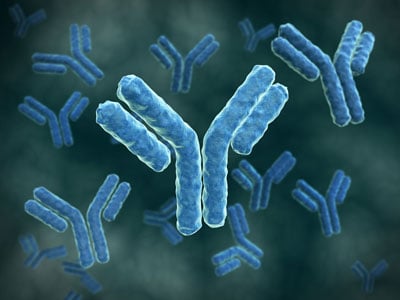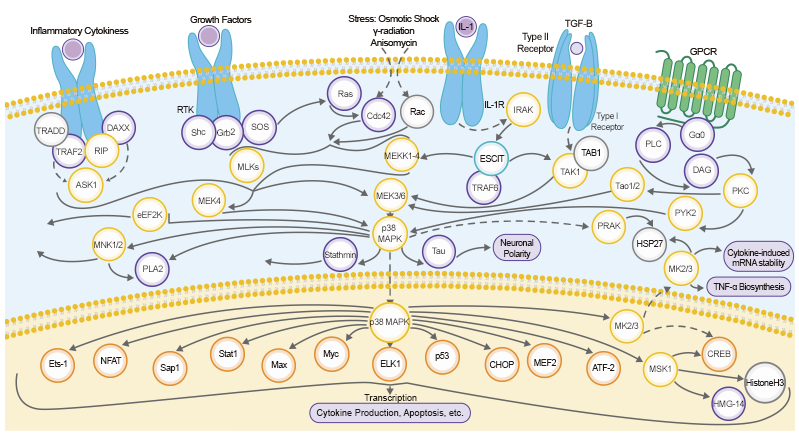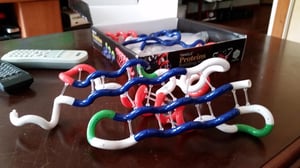 When living in Chicago, we would often get off on the 31st Street exit on Lakeshore Drive, and at the time there was a sign pointing out some parking areas for McCormick Place. I recall specifically that two of those were labeled "E2" and "E3" and being the gigantic nerd that I am, thought immediately of ubiquitin. Since it is found in every type of cell in all eukaryotic cells, the protein is appropriately named. Check out the cool ribbon model I made of ubiquitin for my students once upon a time, and then let's take a look at ubiquitin's functions in living organisms and how it contributes to health and disease.
When living in Chicago, we would often get off on the 31st Street exit on Lakeshore Drive, and at the time there was a sign pointing out some parking areas for McCormick Place. I recall specifically that two of those were labeled "E2" and "E3" and being the gigantic nerd that I am, thought immediately of ubiquitin. Since it is found in every type of cell in all eukaryotic cells, the protein is appropriately named. Check out the cool ribbon model I made of ubiquitin for my students once upon a time, and then let's take a look at ubiquitin's functions in living organisms and how it contributes to health and disease.
What is Ubiquitin and How Does it Work?
Over the past nearly half-century since its discovery, many aspects of the functions and regulation of ubiquitin have been discovered. The careful maintenance of protein levels within the cell relies on tight control of the ubiquitin-proteasome machinery. We explored the dysregulated buildup of cellular proteins and its ramifications in a previous blog, but in a healthy, functional cell, addition of ubiquitin (known as ubiquitination) and similar modifier proteins such as NEDD8 (neddylation) or the small ubiquitin-like modifier (SUMO, in a process called SUMOylation) is used to determine the fate of target proteins and ensure a proper balance. 1 Ubiquitin-mediated regulation affects cell cycle regulators such as cyclins, signaling cascade molecules downstream of growth factor receptors, the selective destruction of damaged or aberrant proteins, and immune functions. 1
Ubiquitination requires the activation of ubiquitin by an E1 enzyme, such as UBA1, in an ATP-dependent reaction. Subsequently, the activated ubiquitin is transferred to a conjugating enzyme termed E2 (an example being UBCH7), and then subsequently ligated to its target protein using an E3 ubiquitin ligase such as Cbl-B, which helps regulate immune functions. 1, 2 In the ubiquitin pathway, a single E1 enzyme can bind multiple E2 enzymes, which in turn can interact with hundreds of E3s to coordinate the downstream processes that determine the target protein's ultimate fate. Ubiquitin molecules can be added singly and also in linear or branched chains depending on which lysine residue is used as the branch point.
The Myriad Functions Regulated by Ubiquitin
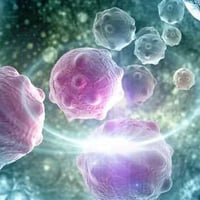 In addition to the functions mentioned above, ubiquitination is involved in a diverse array of cellular processes that includes apoptosis, DNA repair, cellular differentiation, and antigen processing and presentation. 1 In my doctoral project where our team mapped the interactome between Src-homology 2 domain-containing proteins and phosphotyrosine motifs, one of the proteins we worked with was CBL, an E3 ubiquitin ligase which acts as a negative regulator of immune activation to tightly control immune tolerance. 2 There are also E3 ligases that help resolve stalled ribosomes during translation as part of the overarching cellular quality control system. 3 Cdc48, known as VCP in humans, is a protein that helps unfold targeted proteins that have been polyubiquitinated, and facilitates the extraction of membrane-bound proteins, among other targets, to direct for proteasome-mediated degradation. 4
In addition to the functions mentioned above, ubiquitination is involved in a diverse array of cellular processes that includes apoptosis, DNA repair, cellular differentiation, and antigen processing and presentation. 1 In my doctoral project where our team mapped the interactome between Src-homology 2 domain-containing proteins and phosphotyrosine motifs, one of the proteins we worked with was CBL, an E3 ubiquitin ligase which acts as a negative regulator of immune activation to tightly control immune tolerance. 2 There are also E3 ligases that help resolve stalled ribosomes during translation as part of the overarching cellular quality control system. 3 Cdc48, known as VCP in humans, is a protein that helps unfold targeted proteins that have been polyubiquitinated, and facilitates the extraction of membrane-bound proteins, among other targets, to direct for proteasome-mediated degradation. 4
One of the classic examples of regulation by ubiquitin is p53, a critical tumor suppressor that is often lost or inactivated in many types of cancers. Like many other proteins, p53 can be regulated through post-translational modifications (PTMs), which include acetylation, methylation, phosphorylation, and ubiquitination. 5 The various PTMs spatially and temporally activate or attenuate p53 depending on the physiological requirements of the cell. In particular, the reversible ubiquitination of p53 directly affects the levels of p53 and thus p53 activity in the cell. The primary E3 ligase targeting p53 is Mdm2, although there are other E3 ligases that can regulate the p53 abundance within the cell. As part of the stringent regulatory mechanism, p53 exists in a negative transcriptional feedback loop with Mdm2 to keep p53 levels low during normal cell function, but will repress Mdm2 transcription when the cell is stressed by factors such as DNA damage to maintain high levels of p53 that trigger repair mechanisms or apoptosis. 5 Other E3 ligases, such as Msl2, facilitate the nuclear export of p53 into the cytoplasm where it can perform its actions. 5, 6
Ubiquitin and Disease
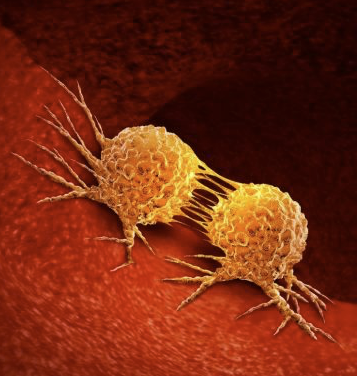 As we previously discussed, the proper application of ubiquitination and proteasomal degradation is needed to ensure cellular health. Buildup of aberrant proteins can overwhelm the vesicular transport system, and could contribute to cancer and neurodegenerative disorders. In the case of p53, in addition to being knocked out by mutation, the overexpression of Mdm2 could lead to unwanted degradation of p53 during cellular stress and could contribute to cancer progression. It is logical that this axis would be a popular therapeutic target, as both inducers of p53 and inhibitors of Mdm2 have been explored. 5
As we previously discussed, the proper application of ubiquitination and proteasomal degradation is needed to ensure cellular health. Buildup of aberrant proteins can overwhelm the vesicular transport system, and could contribute to cancer and neurodegenerative disorders. In the case of p53, in addition to being knocked out by mutation, the overexpression of Mdm2 could lead to unwanted degradation of p53 during cellular stress and could contribute to cancer progression. It is logical that this axis would be a popular therapeutic target, as both inducers of p53 and inhibitors of Mdm2 have been explored. 5
With Rare Disease Day coming at the end of February, there are certain rare diseases that arise from a disruption in the normal ubiquitin machinery. It is known that genetic defects in components of the ubiquitin and proteasome pathway contribute to neurological disorders. One recent case study profiled a child who exhibited many developmental issues including lack of speech and neuromotor abnormalities. 7 It was discovered that the patient had a missense mutation in the FEM1C gene, which codes for a cullin-RING E3 ligase substrate receptor. The mutation was tested in animal and computer models and found to have impaired mobility and a defect in binding its target proteins. 7
How ABclonal Can Help
As an original reagent manufacturer, ABclonal can provide numerous reagents to known factors in the ubiquitin-proteasome pathway, as well as generate custom reagents to novel targets in your unique research path. I've thrown in some links to our catalog antibodies to the stated targets above, and we would love to help you design and produce customized antibodies and proteins. Feel free to contact us at service@abclonal.com for any questions and for additional details.
References
- Ciechanover A & Schwartz AL (1998) "The ubiquitin-proteasome pathway: The complexity and myriad functions of proteins death." PNAS 95(6):2727-2730.
- Lutz-Nicoladoni C, Wolf D & Sopper S (2015) "Modulation of immune cell functions by the E3 ligase Cbl-b." Front Oncol 5:00058 (Epub).
- Oltion et al. (2023) "An E3 ligase network engages GCN1 to promote the degradation of translation factors on stalled ribosomes." Cell 186(2):346-362.
- Williams et al. (2023) "The Ufd1 cofactor determines the linkage specificity of polyubiquitin chain engagement by the AAA+ ATPase Cdc48." Molecular Cell 83:1-11 (Advanced Print)
- Brooks CL & Gu W (2011) "p53 regulation by ubiquitin." FEBS Letters 585:2803-2809.
- Kruse JP & Gu W (2009) "MSL2 Promotes Mdm2-independent Cytoplasmic Localization of p53." Journal of Biological Chemistry 284(5):3250-3263.
- Dubey et al. (2022) "A novel de novo FEM1C variant is linked to neurodevelopmental disorder with absent speech, pyramidal signs and limb ataxia." Human Molecular Genetics (Epub).


